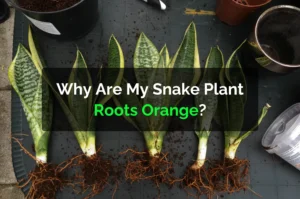Curling happens when your snake plant stays dry for too long. While it doesn’t need frequent watering, neglecting it completely can cause issues. Water only when the top 50% of the soil is dry. Overwatering can also lead to curling, so ensure proper drainage to keep your plant healthy and thriving.
Common Causes of Snake Plant Curling
1. Underwatering
One of the most common reasons for curling leaves is underwatering. Snake plants store water in their thick leaves, but prolonged dryness can cause the leaves to curl inward to conserve moisture.
Symptoms:
Dry, wrinkled, or curling leaves.
Solution:
Water your snake plant when the top 1-2 inches of soil are dry. Avoid overwatering, as it can lead to root rot.
2. Overwatering and Root Rot
Ironically, too much water can also cause curling. When the roots sit in soggy soil, they can rot, preventing the plant from absorbing water and nutrients, leading to curled leaves.
Symptoms:
Yellowing, mushy leaves, and a foul smell from the soil.
Solution:
Use well-draining soil and a pot with drainage holes. If you suspect root rot, remove the plant, trim off rotten roots, and repot it in fresh soil.
3. Pest Infestation
Pests like spider mites and thrips suck the sap from snake plant leaves, causing them to curl, discolor, and become deformed.
Symptoms:
Tiny bugs, webbing, or white spots on the leaves.
Solution:
Inspect the leaves for tiny bugs or webbing. Use neem oil or insecticidal soap to get rid of pests.
4. Temperature Stress
Extreme temperatures or sudden changes in climate can stress your snake plant. Exposure to cold drafts or excessive heat can cause curling.
Symptoms:
Leaves curling inward or outward, discoloration.
Solution:
Keep your plant in a stable environment with temperatures between 60-80°F (16-27°C). Avoid placing it near air conditioners or heaters.
5. Nutrient Deficiency
A lack of essential nutrients like magnesium or nitrogen can weaken the leaves, making them curl.
Symptoms:
Slow growth, pale or yellowing leaves, and curling edges.
Solution:
Feed your snake plant with a balanced houseplant fertilizer once every 2-3 months during the growing season.
6. Poor Light Conditions
Too much direct sunlight can scorch the leaves, while too little light can weaken them, causing them to curl.
Symptoms:
Scorched, yellowing, or drooping leaves.
Solution:
Place your snake plant in bright, indirect light. It can tolerate low light but will thrive in moderate lighting.
7. Pot Size Issues
If your snake plant is root-bound in a small pot, it may struggle to get enough nutrients and water, leading to curling leaves.
Symptoms:
Roots growing out of drainage holes, stunted growth.
Solution:
Repot your plant into a slightly larger pot every couple of years to allow room for growth.
Preventing Snake Plant Curling
- Maintain a consistent watering schedule.
- Use well-draining soil to prevent root rot.
- Inspect your plant regularly for pests.
- Keep it in a stable temperature environment.
- Provide adequate indirect light for healthy growth.
- Fertilize occasionally for proper nutrient balance.
Frequently Asked Questions (FAQs):
How do I know if my snake plant is overwatered or underwatered?
Overwatered plants have mushy, yellowing leaves, while underwatered plants have dry, curling leaves. Check the soil moisture before watering.
Can a curling snake plant recover?
Yes! Once you address the underlying issue, new healthy growth will emerge, and the existing leaves may improve in appearance.
Should I cut off curled leaves?
If the leaves are severely damaged, you can trim them off to encourage new growth.
By identifying the cause of curling leaves and taking the right steps, your snake plant can bounce back to good health. Keep an eye on its care routine, and you’ll have a thriving, beautiful plant!







2 thoughts on “Why Is My Snake Plant Curling?”
I appreciate your work, regards for all the useful articles.
I just like the valuable info you supply for your articles. I’ll bookmark your blog and test again right here regularly. I’m relatively certain I will learn plenty of new stuff proper right here! Best of luck for the following!